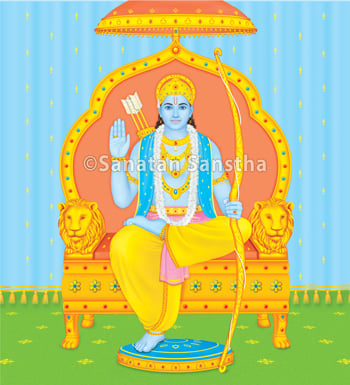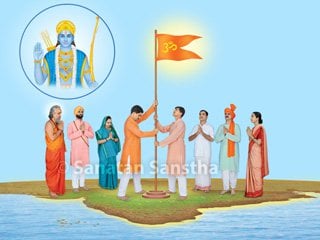1. Shri ram Navami Tithi
Chaitra Shukla pakshaNavami (Ninth day of the bright fortnight of the Hindu lunar month of Chaitra)
2. History
Shri ram Navami is celebrated to commemorate the birth of Shriram, the seventh Incarnation of Shrivishṇu. Ramachandra was born in Ayodhya on this day, during Punarvasu nakshatra (Lunar asterism) at twilight in karka lagan, when the Sun and five other planets etc. were positioned.

Celebrations of Shri ram navami start on the first day of Chaitra (Gudhi Padwa) and continue for 9 days. During this period, devotees do periodic readings of Ramayan, recite hymns glorifying Shriram (Ramraksha stotra), sing Holy devotional songs (Bhajan-Kirtan) in His praise and chant His Name.
On the 9th day, in the afternoon, a spiritual discourse on Shriram’s birth is organised.
3. Importance of Shri ram Navami
Why celebrate any Deity’s festival on a particular tithi ?
On a particular tithi (Date according to the Hindu Almanac) related to a Deity, the respective Deity Principle is most active in the entire universe. Due to this, the Deity’s Chaitanya (Divine consciousness) and sattvikta are emitted in a greater proportion.
The Principles of Deities and Incarnations are more active on earth on the day of their birth as per the Hindu lunar calendar. On the day of Shri ram Navami, Shriram’s Principle is a thousand times more active when compared to other days. On this day, chanting ‘II Shri Ram Jai Ram Jai Jai Ram II’ and worshipping Deity Ram with bhav (spiritual emotion) helps in obtaining maximum benefit of Deity Ram’s Principle.
Watch videos on ‘Ramnavami’
4. Celebrating Shriram Navami
Shri ram navami is called a Holy festival when it is celebrated individually, and a religious festival when celebrated collectively and when performed individually with a resolve it becomes a Vowed religious observance (known as vrat). Also, unlike most vrats which are celebrated individually, Shriramnavami is a vrat celebrated collectively.
Many temples of Shriram celebrate this festival for nine days, beginning from the first day of Chaitra (Gudhi Padwa). During these nine days, reciting the Ramarakshastotra eleven times daily with a resolve brings the prayer to fruition, yielding benefits such as reduction of speech impairments, other ailments, prosperity etc.
On the ninth day, in the afternoon a spiritual discourse on Shriram’s birth is held. At noon, a coconut draped in a hooded cloak is placed in a cradle and the cradle is rocked gently. Devotees shower gulal (a red, fragrant powder) and flowers onto it. (At some places an Idol of Shriram is kept in a cradle instead of a coconut.) On this occasion, songs describing the events at Shriram’s birth are sung. Then, the Idol of Shriram is worshipped and sauntha (Dried ginger powder) is served as prasad. At some places mahaprasad is served along with dried ginger. Many places in North India organise fairs on this festival, culminating in spectacular fireworks on Shriramnavami.
Reference : Sanatan’s Holy Text ‘Holy festivals, Religious festivals and Vowed religious’
Listen Shriram chant : https://www.sanatan.org/en/a/187.html
Audio of Arti of Shri Ram : https://www.sanatan.org/en/a/100495.html
Listen Shriramraksha Stotra : https://www.sanatan.org/en/a/185.html

 Let us make a resolve (sankalp) to establish Ramrajya (Rama’s rule of righteousness) on the...
Let us make a resolve (sankalp) to establish Ramrajya (Rama’s rule of righteousness) on the...